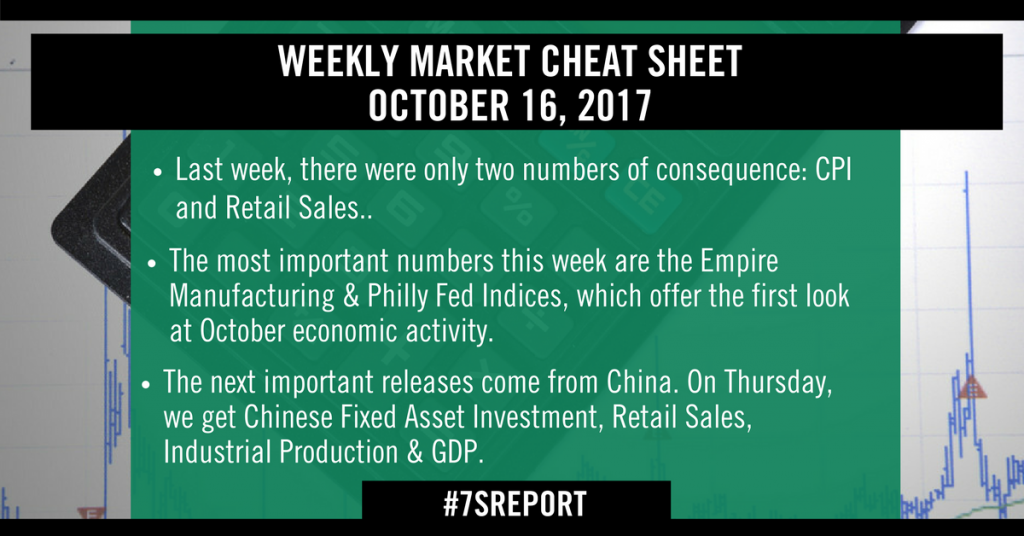Weekly Market Preview, October 16, 2017
Last Week in Review
The major takeaway from last week was that inflation remained stubbornly low in September and that took some of the momentum out of the recent reflation rebound. A decent retail sales number helped salvage the week’s economic data in aggregate, so the fallout for stocks was contained.
From a longer-term view, the fact that inflation remains stubbornly low does undermine the economic reflation that is needed to carry stocks materially higher, given valuations and the economic outlook.
Bottom line, last week wasn’t a particularly good one for the macro bulls, but given retail sales, it didn’t warrant a reversal of the September rally, either.
Looking at the important economic data from last week, there are really only two numbers of consequence: CPI and Retail Sales. The former was a disappointment, as the headline rose 0.5% vs. (E) 0.6% thanks to a hurricane-related surge in energy prices. Core CPI rose just 0.1% vs. (E) 0.2%, and the year-over-year Core CPI declined to 1.7% from 1.8%.
That’s well below the Fed’s 2% stated goal (and given how CPI is constructed, the real CPI goal for the Fed is probably more than 2.5%). So, the Fed still is not creating the type of statistical inflation it wants to.
While the inflation data was disappointing, the growth data on Friday was good. September retail sales were light on the headline at 1.6% vs. (E) 1.8%, but that was because of a dip in auto sales. The more important “control” group, which is retail sales less autos, gas and building supplies (it gives us the best
look at truly discretionary consumer spending), rose 0.4% vs. (E) 0.2%. Importantly, the August core Retail Sales reading was revised to 0.2% from flat.
Looking elsewhere economically last week, there were other reports (NFIB, Chinese Trade Balance, European IP), but none provided any big surprises and none will influence the next direction for stocks or bonds. Bottom line, taken in aggregate (and thanks to retail sales) the economic data last week was close enough to “Goldilocks” to prevent a reversal of the September rally.
From a Fed standpoint, the data this week coupled with some dovish Fed comments turned a December rate hike from a “sure thing” to a “probably,” unless we get more soft inflation or growth readings. That helped push stocks slightly higher on Friday initially, but a Fed that can’t hike rates to 1.5% from 1.25% for fear of low inflation or economic growth isn’t the prescription to materially higher stock prices.
This Week’s Preview
There are a lot of anecdotal economic reports this week that, when taken in aggregate, should give us decent insight into the current state of the US economy, and whether we’re seeing growth accelerate.
The most important numbers this week are the Empire Manufacturing and Philly Fed Indices, which offer the first look at October economic activity. Since the creation of the national flash PMIs, Empire and Philly have lost some of their significance, but this week they are the only October data points, so they’ll be watched to see if economic momentum in September carried over into October.
Away from Empire and Philly, the next more important releases come from China. On Thursday, we get Chinese Fixed Asset Investment, Retail Sales, Industrial Production and GDP. None of these should offer any surprises, but if they are weaker than expected that could cause a mild headwind on stocks.
Finally, this week we get September Industrial Production. Remember, “hard” economic data has, until very recently, badly lagged “soft” survey-based data. In September, retail sales helped close that gap some, but industrial production has remained well below levels you would think given the PMIs. If industrial production can accelerate in September (and remember the key is the manufacturing sub-component), then that will be a good signal that actual economic activity is finally accelerating to meet survey data (a positive for stocks).
Time is money. Spend more time making money and less time researching markets every day. Subscribe to the 7sReport.com.









